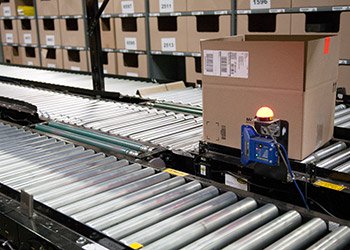
6 Popular Applications for the Hytrol EZLogic System
Jim Sutherin | 14 August 2014
Hytrol’s EZLogic® conveyor is a versatile product, capable of filling many applications. However, are you aware of everything you can program EZLogic® eyes and modules to do? If not, take a look at 6 common applications and features of Hytrol’s EZLogic® conveyor, as well as explanations for each setting.
1. Slug and Singulate
The first mode you should determine for your conveyor line is whether to slug and singulate the release of your product. This modifies how product is released when sequential zones are given run signals. If a zone is in slug mode, it will release the product the same time the zone ahead of it turns on. This is generally a quicker release of product as all slug zones will move at the same time. A zone in singulate mode will wait until the zone ahead of it is clear which creates a gap between each item.
2. Dynamic and Fixed Zone Length
EZLogic® conveyors can handle varying products on the same line. When a conveyor is in singulation mode, each zone will have a fixed zone length set based on the original spacing of the modules. If you have product longer than a zone length, however, you can use dynamic zone lengths to give that carton multiple base zone lengths to compensate the zone release. This method is ideal for mixed product of varying lengths.
3. Accumulation Delay
When a zone is told to stop, it is possible to delay the signal to run the carton into the one ahead of it. This crowding gives the most amount of product per linear foot and the most accumulation for your conveyor. However, make sure your product is able to withstand the backpressure of hitting the cartons together. The default run time is 1.8 seconds, but can be adjusted as a special function.
4. Loading and Unloading Zone Function
If workers are pulling from or putting onto the line directly, it might be worth putting a delay in releasing the products until all personnel and equipment are clear. The loading function will delay the release of a zone if a product triggers the photo eye. If you’re pulling a product off instead and want to pause the zones upstream, you can use the unloading zone function. Neither feature will disrupt the natural flow of the cartons if they are coming down the line.
5. Cascade Release
This function is only available for slug mode, but it acts as a quicker way to pull a gap than singulation. A cascade release will not run all zones at the same time as slug mode usually does, but will include a slight delay between each zone. This pulls a small gap as each product starts to move.
6. Merge Control
E-24 conveyor is versatile enough that it can also be used to merge conveyor lines together. Under the special functions of EZLogic® is programming for a simple spur or 90-degree merge. Both infeed zones will regulate a staggered release of product from each line. While it lacks some of the customization, it might be all you need in simple operations or light case flow. Keep in mind, EZLogic® can actually do more than what I’ve listed above. Using these six features will get you started on your accumulation project.
Comments
No comments have been posted to this Blog Post
Leave a Reply
Your email address will not be published.
Comment
Thank you for your comment.